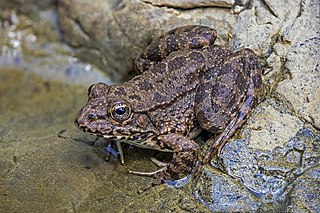
True frogs is the common name for the frog family Ranidae. They have the widest distribution of any frog family. They are abundant throughout most of the world, occurring on all continents except Antarctica. The true frogs are present in North America, northern South America, Europe, Africa, and Asia. The Asian range extends across the East Indies to New Guinea and a single species, the Australian wood frog, has spread into the far north of Australia.
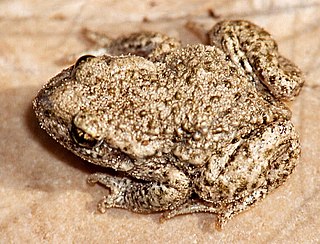
The Alytidae are a family of primitive frogs. Their common name is painted frogs or midwife toads. Most are endemic to Europe, but three species occur in northwest Africa, and a species formerly thought to be extinct is found in Israel.

The southern frogs form the Leptodactylidae, a name that comes from Greek meaning a bird or other animal having slender toes. They are a diverse family of frogs that most likely diverged from other hyloids during the Cretaceous. The family has undergone major taxonomic revisions in recent years, including the reclassification of the former subfamily Eleutherodactylinae into its own family the Eleutherodactylidae; the Leptodactylidae now number 206 species in 13 genera distributed throughout Mexico, the Caribbean, and Central and South America. The family includes terrestrial, burrowing, aquatic, and arboreal members, inhabiting a wide range of habitats.

The Cycloramphidae are a family of frogs endemic to southeastern Brazil. This family has seen large changes in its composition. Genera that have at some point been included in the Cycloramphidae are at present placed in the Alsodidae, Hylodidae, Leptodactylidae, and Rhinodermatidae. Of these, the Alsodidae and/or Hylodidae have also been considered as subfamilies of Cycloramphidae ; the Cycloramphidae, as recognized at present, would be similar to subfamily Cycloramphinae under such system.

Alsodes is a genus of alsodid frogs found in Chile and Argentina. It is the most species-rich frog genus in Patagonia. Common name spiny-chest frogs has been coined for them.

Eupsophus is a genus of frogs in the family Alsodidae. They are sometimes known as ground frogs. The genus is endemic to Patagonia. Eupsophus is the second most species-rich frog genera of Patagonia. These frogs are restricted to forested areas at southern latitudes.

Alsodes gargola, with the common name Tonchek spiny-chest frog, is a species of frog in the family Alsodidae. It is endemic to Argentina, where it occurs in northern Patagonia.
Alsodes igneus is a species of frogs in the family Alsodidae endemic to Chile; it is only known from its type locality, Tolhuaca National Park, Malleco Province, on the western slopes of the Andes. The specific name igneus, meaning "something that is of fire", was chosen to symbolize the survival of the population from a great forest fire that affected the type locality in 2000.

Alsodes pehuenche is a species of frog in the family Alsodidae. It is endemic to Pehuenche Valley in the Andes of southern Mendoza Province, Argentina, and the adjacent Chile. At the time of the assessment by the International Union for Conservation of Nature (IUCN) in 2012, the species was known from six streams in an area encompassing some 9 km². A study published in 2013 extended the known range a few kilometers west and included another Chilean stream.

Alsodes vanzolinii is a species of frog in the family Alsodidae.
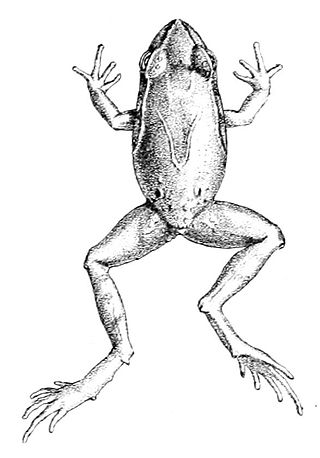
Eupsophus calcaratus is a species of frog in the family Alsodidae. It is endemic to Patagonia. It has one of the broadest distributions of any Chilean frog.

Limnomedusa macroglossa is a species of frog in the family Alsodidae, in the monotypic genus Limnomedusa. It is found in southern Brazil, northeastern Argentina, Uruguay, and northern Paraguay.

The Petropedetidae are a family of frogs containing three genera and 12 species. They are found in sub-Saharan tropical Africa and are sometimes known under common name African torrent frogs.

The frog family Dicroglossidae occurs in tropical and subtropical regions of Asia and Africa, with most genera and species being found in Asia. The common name of the family is fork-tongued frogs.

Brevicipitidae or rain frogs is a small family of frogs found in eastern and southern Africa. As of 2020 contains 37 species in 5 genera. Formerly included as subfamily in Microhylidae, phylogenetic research has indicated the brevicipitine frogs should be considered as a family with Hemisotidae as the most closely related sister taxon.
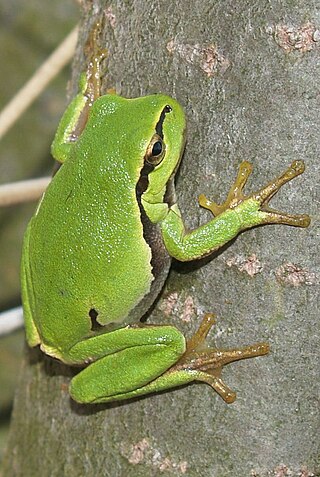
Hylinae is a large subfamily of "tree frogs", family Hylidae.

The Odontophrynidae are a family of frogs from southern and eastern South America. This family was first established in 1969 as the tribe Odontophrynini within the (then) very large family Leptodactylidae. Molecular phylogenetics analyses prompted the move of this group to the Cycloramphidae in 2006, before they became recognized as their own family Odontophrynidae in 2011.

Hylodidae, commonly known as giant Neotropical torrent frogs, is a family of frogs native to Brazil and northern Argentina. Phylogenetic evidence suggests the Hylodidae being the sister group to the Alsodidae.

The Leiuperinae are a subfamily of frogs in the family Leptodactylidae. Over 90 species are in five genera. The distribution of this subfamily is from southern Mexico to the Central America and much of South America.
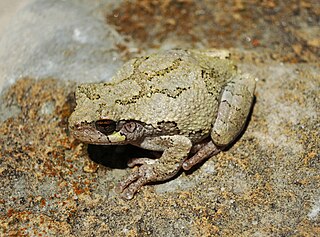
Dryophytes is a genus of Ameroasian tree frogs in the family Hylidae. They are found mostly in North America, but the genus also includes three species found in eastern Asia.




















